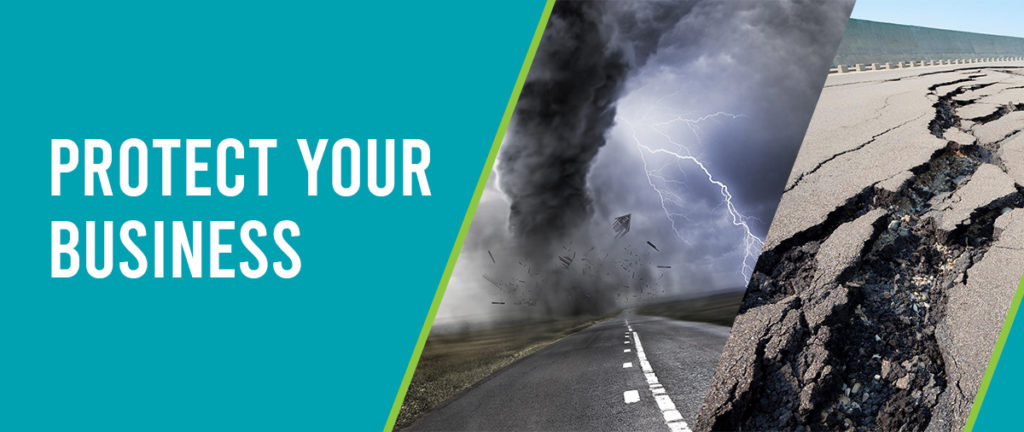
Natural events have become a common occurrence in many parts of the US with a growing number of devastating natural disasters occurring in recent years. Preparing your business for emergency back-up power in the midst of a natural disaster such as an earthquake, hurricane, ice storm or flood is crucial for business continuity.
Earthquakes
In the US alone, the National Earthquake Information Center locates about 12,000-14,000 earthquakes per year. Globally there are approximately 55 earthquakes per day averaging out to 20,000 a year!
During an earthquake, a building’s emergency equipment may inevitably experience vigorous shaking and movement depending on the magnitude. Acquiring back-up equipment that is OSHPD “OSP” Special Seismic Certified provides enormous value in knowing your equipment has been shaker-table tested and certified to endure major earthquakes without fail. However, earthquakes aren’t just about shaky buildings, earthquakes also have the power to cause damage to electrical grids and powerlines. When either of the two are down, electricity and power can go out resulting in a loss of power to your business. This ultimately results in loss revenues, product and production to name a few. Where critical facilities are concerned, this could mean life or death.
Wind and Storms
High winds from hurricanes, tornadoes, and severe storms affect emergency power every year and are one of the most common causes of power outages. In 2020, NOAA reported a record-breaking 30 named storms (top winds of 39 mph or greater), of which 13 became hurricanes (top winds of 74 mph or greater), including six major hurricanes (top winds of 111 mph or greater). 2020 became the year with the most storms ever recorded in the continental United States. A report from Climate Central states that 44 percent of power outages are caused by storm events which negatively impact businesses and homes.
Strong winds tend to blow large debris resulting in broken power lines and utility poles. They can also cause lines to swing together which can result in short circuiting utility power. Strong winds are also traced to the cause of wildfires. Utility companies have begun to implement “Public Safety Power Shutoffs” in order to tackle the event of severe winds and prevent wildfires from occurring. With consistent power outages during severe winds, businesses are forced to find alternatives to utility power in order to keep the lights on during these long shutoffs.
Ice Storms
Ice storms fall into the “winter weather” category and occur in the U.S. primarily during the months of December and January. Also known as freezing rain, these storms occur when rain freezes and accumulates on surfaces such as trees, power lines, and the ground.
Severe damage to trees and power lines begins when ice accumulates between a quarter- and half-inch. When these ice droplets accumulate onto powerlines it can add up to 500 pounds of extra weight. With the amount of weight added by ice layers, trees and utility lines tend to fall and result in damage to roads, homes, and businesses. It can take quite a while for trees to be removed from roads and powerlines to be repaired, this can result in a loss of electricity and heat for many days. In January 2020, an Atlanta ice storm left half a million people without power, some for more than a week while utility companies tried to repair lines. Estimated total losses reported for this storm reached upwards of $48 million. In mid-December of 2020, an ice storm left more than 500,000 without power in parts of Texas, Oklahoma and Arkansas. At the time, it was called one of the most destructive ice storms seen to the electrical utility infrastructure in those areas. In February 2021 more than 700,000 people were without power due to ice storms in eight states including Nevada, Oregon, Washington, Kentucky, North Carolina, West Virginia, and Virginia.
Knowing that ice storms can last up to a few days, preparing ahead of time is the best decision. Businesses with back-up power solutions are able to sustain these winter events and keep the lights and heat on when it is needed the most.
Floods
According to the department of agriculture, ninety percent of all natural disasters in the United States involve flooding. Additionally, high-risk flood areas are not the only ones at risk, about 25% of flood insurance claims come from moderate-to low-risk areas.
Floods are caused by spring thaw resulting in the overflow of rivers, waterways, dams, etc. They are also caused by coastal flooding due to hurricanes, tropical storms, and heavy rains. Flood surges that occurred in Hurricanes such as Sandy and Katrina severely affected emergency power. Flood damage poses one of the greatest risks to on-site power.
Considering the location of your emergency back-up equipment is paramount when planning for possible flood-damage. The lowest level of a building is the most likely to flood knocking out emergency power distribution equipment, such as transfer switches, rendering switches inoperable. Organizations such as Medical facilities and Universities have begun mounting back-up equipment on the second floor keeping all equipment dry and operational during a flood.
Natural disasters are in abundance. All the U.S. incurs some sort of natural disaster that knocks out power daily. Designing on-site emergency power back-up systems is crucial to business survival and recovery.
Learn how to protect your business with ESL’s back up power solutions.